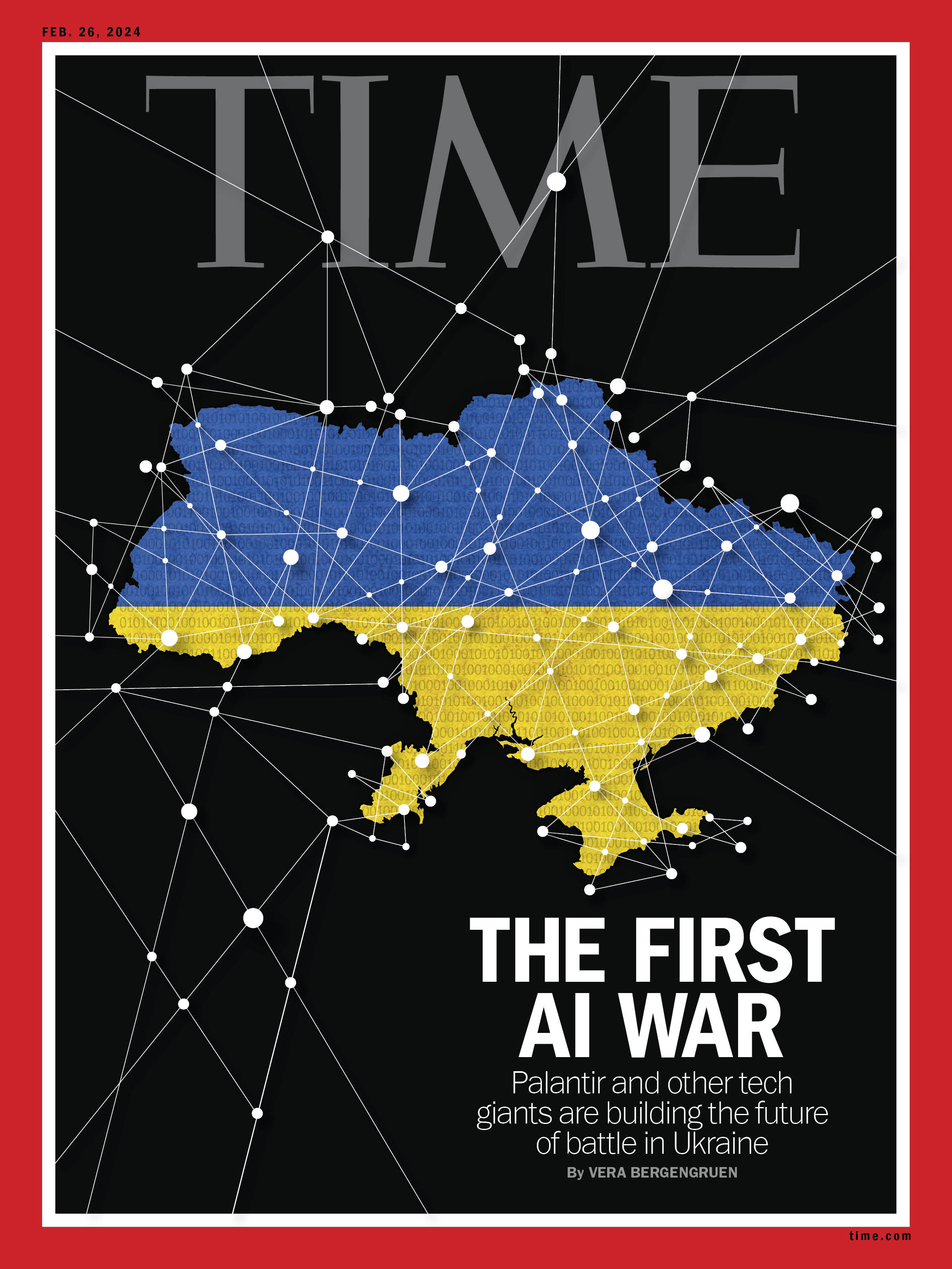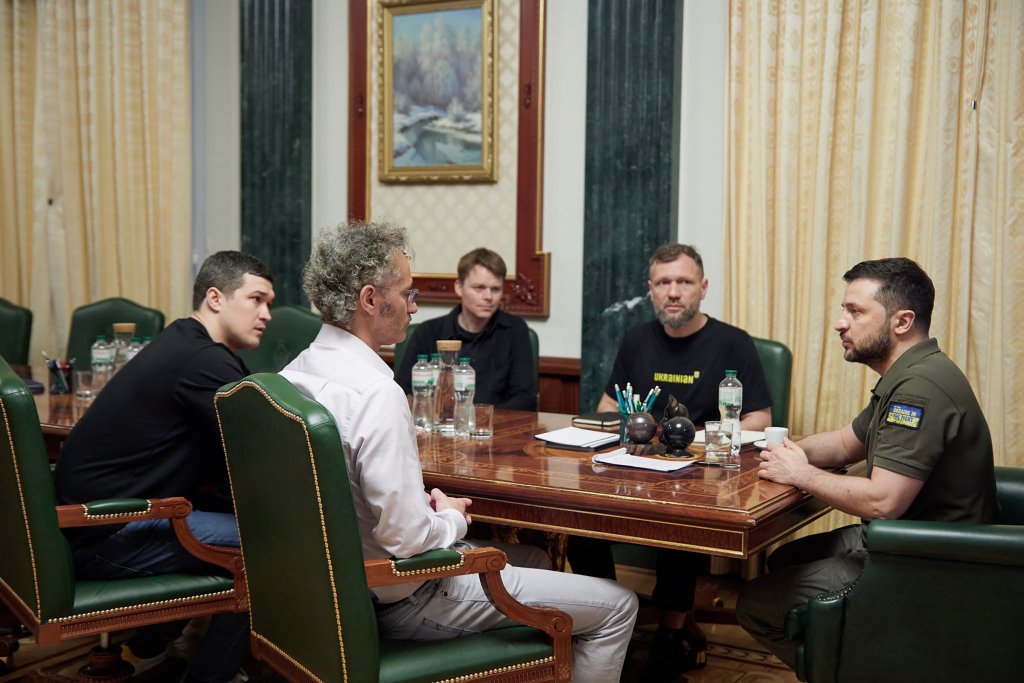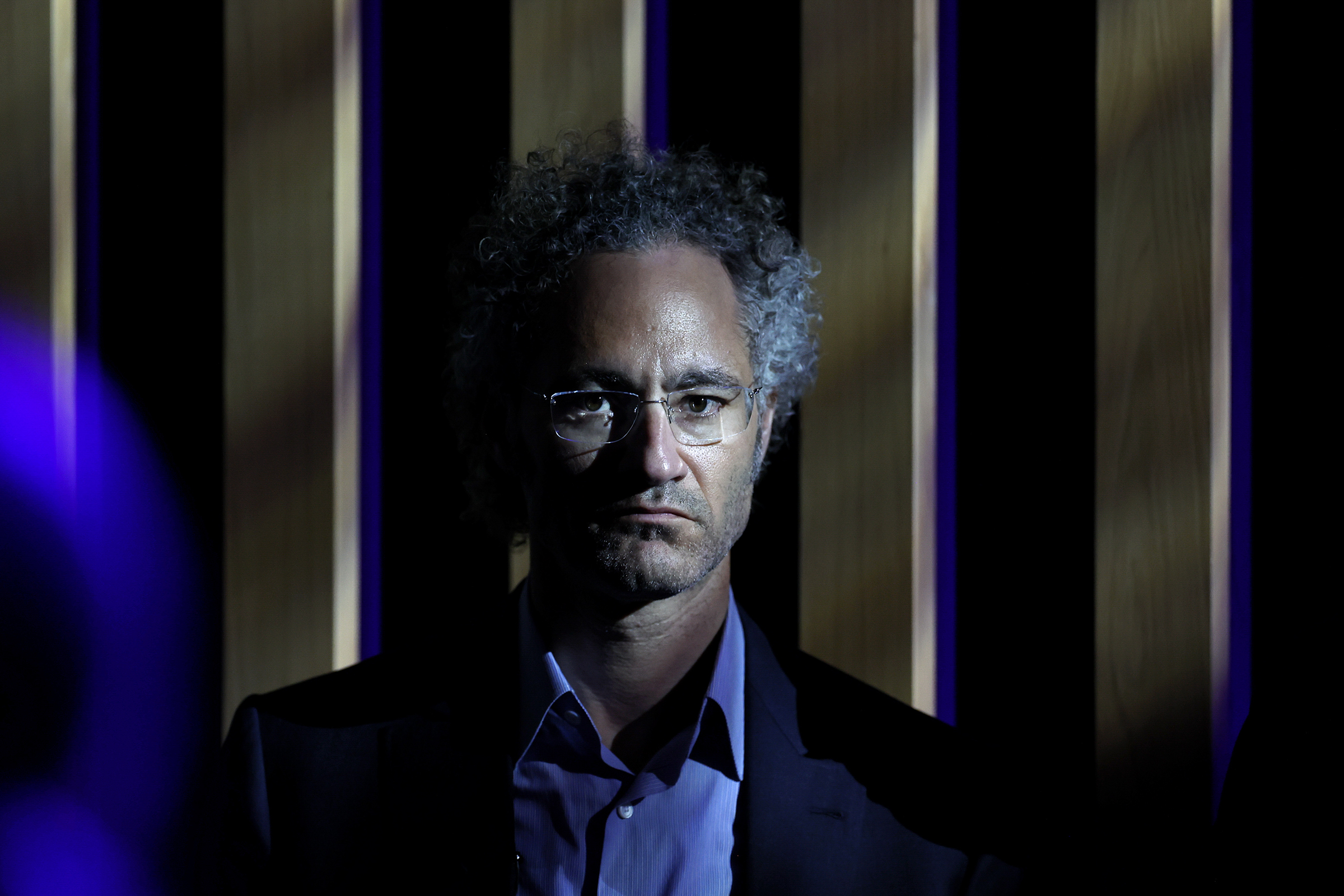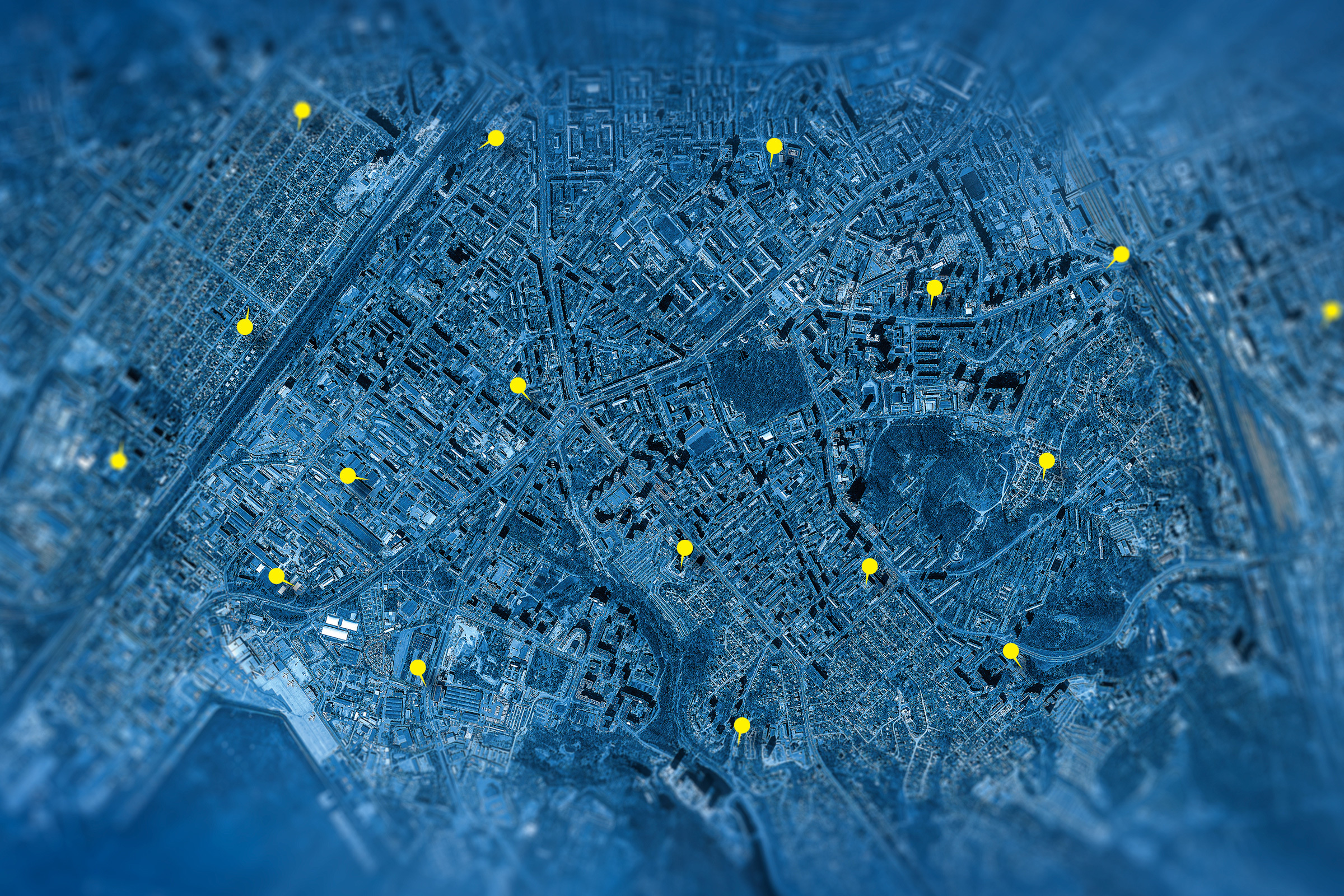Early on the morning of June 1, 2022, Alex Karp, the CEO of the data-analytics firm Palantir Technologies, crossed the border between Poland and Ukraine on foot, with five colleagues in tow. A pair of beaten-up Toyota Land Cruisers awaited on the other side. Chauffeured by armed guards, they sped down empty highways toward Kyiv, past bombed-out buildings, bridges damaged by artillery, the remnants of burned trucks.
They arrived in the capital before the wartime curfew. The next day, Karp was escorted into the fortified bunker of the presidential palace, becoming the first leader of a major Western company to meet with Ukrainian President Volodymyr Zelensky since Russia’s invasion three months earlier. Over a round of espressos, Karp told Zelensky that he was ready to open an office in Kyiv and deploy Palantir’s data and artificial-intelligence software to support Ukraine’s defense. Karp believed they could team up “in ways that allow David to beat a modern-day Goliath.”
In the stratosphere of top tech CEOs, Karp is an unusual figure. At 56, he is a lanky tai chi aficionado with a cloud of wiry gray curls that gives him the air of an eccentric scientist. He has a Ph.D. in philosophy from a German university, where he studied under the famous social theorist Jürgen Habermas, and a law degree from Stanford, where he became friends with the controversial venture capitalist and Palantir co-founder Peter Thiel. After Palantir became tech’s most secretive unicorn, Karp moved the company to Denver to escape Silicon Valley’s “monoculture,” though he typically works out of a barn in New Hampshire when he’s not traveling.
The Ukrainians weren’t sure what to think of the man making grandiose promises across the ornate wooden table. But they were familiar with the company’s reputation, recalls Mykhailo Fedorov, Ukraine’s Minister of Digital Transformation, who was in that first meeting. Named after the mystical seeing stones in The Lord of the Rings, Palantir sells the same aura of omniscience. Seeded in part by an investment from the CIA’s venture-capital arm, it built its business providing data-analytics software to U.S. Immigration and Customs Enforcement (ICE), the FBI, the Department of Defense, and a host of foreign-intelligence agencies. “They are the AI arms dealer of the 21st century,” says Jacob Helberg, a national-security expert who serves as an outside-policy adviser to Karp. In Ukraine, Karp tells me, he saw the opportunity to fulfill Palantir’s mission to “defend the West” and to “scare the f-ck out of our enemies.”

Buy a print of The First AI War cover here
Ukraine saw an opportunity too. At first it was driven by desperation, says Fedorov, 33. With the Russians threatening to topple Zelensky’s democratically elected government and occupy the country, Kyiv needed all the help it could get. But soon, government officials realized they had a chance to develop the country’s own tech sector. From European capitals to Silicon Valley, Fedorov and his deputies began marketing the battlefields of Ukraine as laboratories for the latest military technologies. “Our big mission is to make Ukraine the world’s tech R&D lab,” Fedorov says.
The progress has been striking. In the year and a half since Karp’s initial meeting with Zelensky, Palantir has embedded itself in the day-to-day work of a wartime foreign government in an unprecedented way. More than half a dozen Ukrainian agencies, including its Ministries of Defense, Economy, and Education, are using the company’s products. Palantir’s software, which uses AI to analyze satellite imagery, open-source data, drone footage, and reports from the ground to present commanders with military options, is “responsible for most of the targeting in Ukraine,” according to Karp. Ukrainian officials told me they are using the company’s data analytics for projects that go far beyond battlefield intelligence, including collecting evidence of war crimes, clearing land mines, resettling displaced refugees, and rooting out corruption. Palantir was so keen to showcase its capabilities that it provided them to Ukraine free of charge.
More From TIME
It is far from the only tech company assisting the Ukrainian war effort. Giants like Microsoft, Amazon, Google, and Starlink have worked to protect Ukraine from Russian cyberattacks, migrate critical government data to the cloud, and keep the country connected, committing hundreds of millions of dollars to the nation’s defense. The controversial U.S. facial-recognition company Clearview AI has provided its tools to more than 1,500 Ukrainian officials, who have used it to identify more than 230,000 Russians on their soil as well as Ukrainian collaborators. Smaller American and European companies, many focused on autonomous drones, have set up shop in Kyiv too, leading young Ukrainians to dub some of the city’s crowded co-working spaces “Mil-Tech Valley."
War has always driven innovation, from the crossbow to the internet, and in the modern era private industry has made key contributions to breakthroughs like the atom bomb. But the collaboration between foreign tech companies and the Ukrainian armed forces, who say they have a software engineer deployed with each battalion, is driving a new kind of experimentation in military AI. The result is an acceleration of “the most significant fundamental change in the character of war ever recorded in history,” General Mark Milley, former Chairman of the Joint Chiefs of Staff, told reporters in Washington last year.
Read More: Inside Ukraine's Plan to Arm Itself.
It can be hard to see that from afar. By all accounts, the war in Ukraine has settled into a stalemate, with both sides hammering away with 20th century weapons like artillery and tanks. Some view the claims of high-tech breakthroughs with skepticism, arguing that the grinding war of attrition is little affected by the deployment of AI tools. But Ukraine and its private-sector allies say they are playing a longer game: creating a war lab for the future. Ukraine “is the best test ground for all the newest tech,” Fedorov says, “because here you can test them in real-life conditions.” Says Karp: “There are things that we can do on the battlefield that we could not do in a domestic context.”
If the future of warfare is being beta tested on the ground in Ukraine, the results will have global ramifications. In conflicts waged with software and AI, where more military decisions are likely to be handed off to algorithms, tech companies stand to wield outsize power as independent actors. The ones willing to move fast and flout legal, ethical, or regulatory norms could make the biggest breakthroughs. National-security officials and experts warn these new tools risk falling into the hands of adversaries. “The prospects for proliferation are crazy,” says Rita Konaev of Georgetown’s Center for Security and Emerging Technology. “Most companies operating in Ukraine right now say they align with U.S. national-security goals—but what happens when they don’t? What happens the day after?”

In the months since Karp’s cloak-and-dagger first meeting with Zelensky, Palantir brass have fallen into a familiar routine on their frequent trips into Ukraine. In October, I met a London-based Palantir employee at the airport in Krakow, Poland. We were picked up in two armored cars, handed emergency medical kits “just in case,” and driven to the border with Ukraine. Gone was what one executive described to me as the “Kalashnikov-between-the-knees vibe.” We zipped through the border checkpoint, where young Ukrainian recruits dozed in the light rain. After dozens of these journeys, Palantir employees have their favorite gas-station snacks on the long road to Kyiv; their favorite drivers (a hulking former soldier for the Polish special forces who goes by Horse got us there with terrifying speed); and their favorite specialty coffee shops around the capital. These days, the lobbies of Kyiv’s five-star hotels are full of security details trying to inconspicuously sip beers while waiting for foreign-defense, tech, and government executives.
Much of Palantir’s work there is conducted in stylish co-working spaces by a team of fewer than a dozen local employees who work directly with Ukrainian officials. When I visited one such office in October, three men with close-cropped hair and cargo pants stood out against the trendy crowd of 20-somethings before they disappeared to meet with Palantir employees in a room booked under a fake name. “It often feels like a tech-startup vibe: let’s see what we can do with two old cameras and a drone flying around,” says Vic, an engineer who left their job at a U.S. tech giant to work for Palantir in Kyiv after the invasion, and asked to be identified by a pseudonym for security reasons. “Except we’re in the middle of a war."
With a few clicks, a Ukrainian Palantir engineer showed me how they could mine a dizzying array of battlefield data that, until recently, would have taken hundreds of humans to analyze. Palantir’s software processes raw intelligence from sources including drones, satellites, and Ukrainians on the ground, as well as radar that can see through clouds and thermal images that can detect troop movements and artillery fire. AI-enabled models can then present military officials with the most effective options to target and enemy positions. The models learn and improve with each strike, according to Palantir.
When the company first started working with the Ukrainian government in the summer of 2022, “it was just a question of pure survival,” says Louis Mosley, Palantir’s executive vice president for U.K. and Europe. Palantir hired Ukrainian engineers who could adapt its software for the war effort, while also serving as interlocutors between the tech company and Ukraine’s sclerotic bureaucracy. Government officials were trained to use a Palantir tool called MetaConstellation, which uses commercial data, including satellite imagery, to give a near real-time picture of a given battle space. Palantir’s software integrates that information with commercial and classified government data, including from allies, which allows military officials to communicate enemy positions to commanders on the ground or decide to strike a target. This is part of what Karp calls a digital “kill chain.”


Although recent earnings data from the company indicates that partner countries have chipped in tens of millions to offset Palantir’s investment, Ukraine has not paid Palantir for its tools and services. The company's motivations in Ukraine have little to do with short-term profit. In recent years, Palantir has sought to shed its reputation as a shadowy data-mining spy contractor as it expands its list of commercial clients. Its tools have played a role in uncovering the financial fraud carried out by Bernie Madoff, rooting out Chinese spyware installed on the Dalai Lama’s computer, and allegedly aiding in the hunt for Osama bin Laden—a long-standing rumor the company has been careful not to dispute. More recently it has highlighted its work with the U.N. World Food Programme and the use of its software to track COVID-19 vaccine production and distribution.
Karp has long dismissed widespread criticism that Palantir’s tools enable intrusive government surveillance. Amnesty International has accused the company of seeking to “deflect and minimize its responsibility to protect human rights,” and said Palantir’s tools have allowed government agencies to track and identify migrants and asylum seekers to carry out arrests and workplace raids. The CEO says he sees a moral imperative to supply Western governments with the best emerging technology, calling for “more intimate collaboration between the state and the technology sector” that he believes will allow the West to maintain its edge over global adversaries.
In Ukraine, Palantir had found an opportunity to put this mission into practice while burnishing its reputation. “People often have preconceived notions about Palantir, but our products work,” says vice president Josh Harris. “When it’s existential, and when it needs to work, you take off your blinders, you take out all the politics.” And in Ukraine’s leaders, the company found a group of young, tech-savvy officials who could help them with more than just PR.

When I visited last fall, the stately avenue that leads to Ukraine’s cabinet building in downtown Kyiv was lined with rusted antitank barricades and checkpoints manned by rifle-toting soldiers. The windows of the imposing Soviet-era building that houses most of Zelensky’s government were covered by sandbags. Government workers wove through the darkened hallways, using their phones to light the way.
Fedorov’s sixth-floor office was illuminated by neon lamps. A treadmill, boxing gloves, and an exercise bike made up a small gym in one corner. At a conference table flanked by large screens, a stone sculpture of an alien wore a Biden-Harris 2020 cap. A neat stack of fanned-out magazines near the doorway bore a message to the world: "Ukraine: Open for Business."
For the past 18 months, Fedorov and his deputies have brought that message to tech CEOs, defense conferences, and business summits. The former digital-marketing entrepreneur, who is the youngest member of Zelensky’s cabinet, has framed the battlefields of Ukraine and its modern wartime society as the best possible testing ground for cutting-edge innovation. “The tech sector will be the main engine of our future growth,” Fedorov told me. On the day we spoke in his office, Fedorov had just finished one of his regular calls with leaders at Microsoft and was due to meet with Google executives visiting Kyiv. He has been on the cover of Wired magazine and spoken about Ukraine’s tech achievements in wartime at the World Economic Forum in Davos, Switzerland. It’s a striking turnaround from when I first interviewed Fedorov in March 2022. Back then, he was speaking into Airpods from a darkened bunker with an erratic video connection, and his team was resorting to Twitter to lobby and shame the world’s largest tech companies to block their services in Russia.
Read More: The Man On Ukraine's Digital Front Line.
In the first months of the war, Ukrainian officials accepted whatever help was offered. They took cyber and cloud services from Microsoft, Amazon, and Google; Starlink terminals from Elon Musk; facial-recognition software from Clearview AI; and a host of experimental drones, cameras, and jamming kits from large defense companies and startups alike. Fedorov rallied an “IT Army” of 400,000 volunteer hackers to help protect critical infrastructure and counter Russian cyberattacks. “In the beginning there was no process. There was chaos,” says Alex Bornyakov, Fedorov’s 41-year-old deputy. By that summer, he adds, “we had to calm ourselves down and say, ‘We can’t go on this way. We need a strategy for the long term.’”
The solution they landed on was to build a tech sector that could not just help win the war but also serve as a pillar of Ukraine’s economy when it was over. Israel, a hotbed for tech startups, was a model. Ukraine’s 300,000 tech workers, many employed by American companies before the war, were eager to contribute to the fight by working for the multiplying number of domestic military startups. “We decided, let’s send a message that it’s not about donations,” says Bornyakov. “The best way to help Ukraine is to invest in Ukraine.”
They first tested the new pitch at the Ukraine Recovery Conference in Lugano, Switzerland, that July. The response was swift. Silicon Valley investors launched the Blue and Yellow Heritage Fund to invest in Ukrainian startups. “It is not a charity,” founding partner John Frankel said at the time. “It’s our way of contributing, but also getting what we think will be a high return on capital.”
Fedorov and Bornyakov set up incentives, expanding special tax breaks to defense-tech companies to entice them to come to Kyiv. They launched “trade missions” to conferences in London, San Francisco, Toronto, Brussels, Davos, and Dubai. By early 2023, the road show was almost going too well. “We were bombarded with so much military defense stuff from [startups] saying, ‘I have this idea of how to win the war,’” says Bornyakov. He and Fedorov launched a digital platform called Brave1, through which defense-tech companies, startups, and ordinary Ukrainians can pitch their products. It has received more than 1,145 submissions, hundreds of which are being tested on the battlefield, according to Fedorov’s office. This includes drones, AI-transcription software that could decipher Russian military jargon, radios that prevent Russian jamming, patches for cyber vulnerabilities, and demining equipment.
In meetings with more than a dozen Ukrainian officials, I was given demos of how many of these tools work—and how they’re used for tasks beyond the battlefield. Dmytro Zavgorodnii, a digital official at the Ministry of Education and Science, showed me dashboards with satellite maps tracking schools affected by air-raid alerts or power outages, the condition of roads, and estimates for how long it would take students to access shelters with wi-fi. This software, provided by Palantir, will help the ministry determine how to keep schools open, provide laptops and connectivity in conflict zones, and conduct national testing with minimal disruption. “It’s like a superpower,” Zavgorodnii explained.
Read More: Where Zelensky Comes From.
Huddled around a laptop, Ukrainian Economy Minister Yulia Svyrydenko showed me how Palantir’s software has made it possible to aggregate dozens of previously siloed data streams to help officials clear the country of land mines. Ukraine has become the most heavily mined country in the world, with unexploded ordnance endangering more than 6 million civilians and making vast swathes of farmland unusable. The ministry works with Palantir to develop models to determine where demining efforts could have the biggest impact, helping Svyrydenko devise a plan to bring 80% of contaminated land back into economic use within 10 years. In an interview at a Kyiv hotel, Ukraine’s Attorney General Andriy Kostin told me how his agency employs Palantir’s software in its effort to prosecute alleged Russian war crimes—using its analysis of vast troves of data to link allegations of war crimes to pieces of evidence, including satellite imagery, troop movements, and open-source data like photos and videos uploaded by Ukrainians on social media.
Other tech companies have also been supplying the Ukrainian government with products to help win the war. One of the most successful has been Clearview, which Ukraine’s Deputy Minister of Internal Affairs Leonid Tymchenko described to me as the country’s “secret weapon” against invading Russian troops. It’s being used by 1,500 officials across 18 Ukrainian agencies, and has helped identify more than 230,000 Russian soldiers who have participated in the military invasion, making it possible to link them to evidence of alleged war crimes, according to Ukrainian officials. Clearview is reaping the benefits too. Ukrainian engineers have “definitely made our product a lot better,” its CEO Hoan Ton-That says.
A short drive from downtown Kyiv sits a bustling high-tech “innovation park” called Unit City. It’s a sprawling campus of ultramodern offices built on the grounds of an old Soviet factory that produced knockoffs of German motorcycles. Unit City is the epicenter of Ukraine’s efforts to turn its tech industry “into the main innovation hub in Europe,” says partner Kirill Bondar. Since the start of the war, U.S. and European government officials have visited Unit City; so have tech executives and luminaries like Vitalik Buterin, a creator of the Ethereum cryptocurrency blockchain.
Among the businesses based here is a Ukrainian military startup accelerator called D3 (Dare to Defend Democracy). High-profile foreign investors, including former Google CEO Eric Schmidt, have pumped more than $10 million into D3. In trips to Ukraine, Schmidt says, he became convinced that the country’s front lines would produce breakthroughs in the use of AI and drones. “There’s simply so much volume, there’s so many players, there’s so much innovation,” Schmidt says. “It’s really impressive.”
Schmidt is among an array of prominent foreign investors attracted to the nascent promise of Ukraine’s tech sector. German drone manufacturer Quantum Systems recently announced it would open a research and development center in Kyiv. The Japanese tech giant Rakuten also announced its plan to open an office in the capital. Turkish drone maker Baykar has invested nearly $100 million to build a research and manufacturing center in Ukraine by 2025. At a recent European defense conference, “no one would even look at a product unless it had Tested in Ukraine stamped on it,” Deborah Fairlamb, the co-founder of Green Flag Ventures, a new fund dedicated to investing in Ukrainian startups, told me.
While encouraging the investment, the Ukrainian government is also seeking to preserve valuable battlefield data for its own budding defense industry. Officials told me they intend to export the innovations coming out of the conflict to address a variety of global crises beyond war, from disruptive blackouts to natural disasters. Over time, Kyiv has become much more selective about who they allow to access their front lines to refine their products. “There has been a change in the message,” a senior Palantir executive told me as he left a meeting with officials in Kyiv. “Now it seems they’re saying, ‘You know, you’re lucky to be here.’”
Outside its borders, there are signs that Ukraine’s war lab has helped establish it as a major player on the global tech scene. At Web Summit, the world’s largest tech conference, which took place in Lisbon in November, Ukraine’s pavilion loomed over other exhibits in the cavernous arena. Two years earlier, its presence had been limited to a corner booth. Now 25 Ukrainian startups had set up kiosks, and dozens of young workers in yellow Team Ukraine shirts handed out promotional booklets. “The best time to invest in Ukraine is NOW, not after the war,” its marketing materials read.
Some of the lessons learned on Ukraine’s battlefields have already gone global. Citing Ukraine as a blueprint, Taiwan has recruited commercial drone makers and aerospace firms to embed within the military to build up its drone program amid rising tensions with China. Last month, the White House hosted Palantir and a handful of other defense companies to discuss battlefield technologies used against Russia in the war. The battle-tested in Ukraine stamp seems to be working.
Read More: What to Expect From AI in 2024
So is Palantir’s campaign to rehabilitate its reputation. In early January, amid the ongoing war against Hamas, Israel’s Defense Ministry struck a deal with the company to “harness Palantir’s advanced technology in support of war-related missions.” To Palantir executives, the demand for their tools from one of the world’s most technologically advanced militaries spoke for itself. But they were surprised when the usually discreet Israelis allowed the partnership to be made public, “almost as if the relationship itself would act as a military deterrence,” according to a person familiar with the discussions.
The next generation of AI warfare remains in its early stages. Some U.S. officials are skeptical that it will contribute to a military victory for Ukraine. As the war enters its third year, the Ukrainian counteroffensive has continued to stall. “The tech bros aren’t helping us too much,” Bill LaPlante, the U.S. Undersecretary of Defense for Acquisition and Sustainment, told a defense conference in November. “We’re not fighting in Ukraine with Silicon Valley right now, even though they’re going to try to take credit for it.”
Ukraine’s use of tools provided by companies like Palantir and Clearview also raises complicated questions about when and how invasive technology should be used in wartime, as well as how far privacy rights should extend. Clearview CEO Ton-That contends that, like many new tools in this conflict, his facial-recognition software is “a technology that shines and only really is appreciated in times of crisis.” But alarmed human-rights groups and privacy advocates warn that unchecked access to his tool, which has been accused of violating privacy laws in Europe, could lead to mass surveillance or other abuses.
That may well be the price of experimentation. “Ukraine is a living laboratory in which some of these AI-enabled systems can reach maturity through live experiments and constant, quick reiteration,” says Jorritt Kaminga, the director of global policy at RAIN, a research firm that specializes in defense AI. Yet much of the new power will reside in the hands of private companies, not governments accountable to their people. “This is the first time ever, in a war, that most of the critical technologies are not coming from federally funded research labs but commercial technologies off the shelf,” says Steve Blank, a tech veteran and co-founder of the Gordian Knot Center for National Security Innovation at Stanford University. “And there’s a marketplace for this stuff. So the genie’s out of the bottle.”—With reporting by Leslie Dickstein and Simmone Shah/New York •
More Must-Reads From TIME
- What Student Photojournalists Saw at the Campus Protests
- How Far Trump Would Go
- Why Maternity Care Is Underpaid
- Saving Seconds Is Better Than Hours
- Why Your Breakfast Should Start with a Vegetable
- Welcome to the Golden Age of Ryan Gosling
- The 100 Most Influential People of 2024
- Want Weekly Recs on What to Watch, Read, and More? Sign Up for Worth Your Time
Write to Vera Bergengruen / Kyiv at vera.bergengruen@time.com
